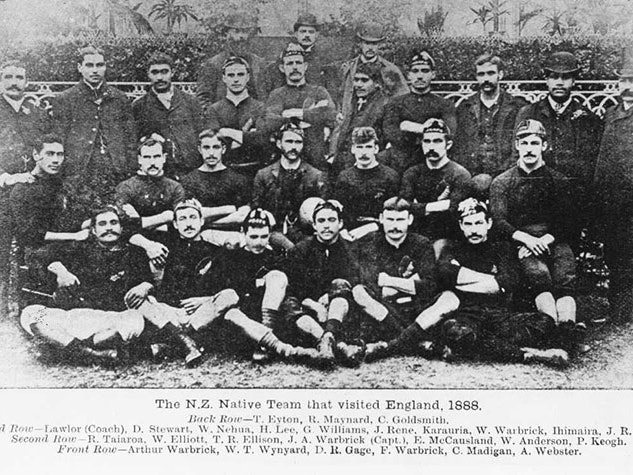
Before the All Blacks: The New Zealand ‘Natives’
The ‘NZ Native Football Representatives’ team was the first New Zealand representative rugby team to tour Britain.
Free museum entry for New Zealanders and people living in New Zealand
Open every day 10am-6pm
(except Christmas Day)
Free museum entry for New Zealanders and people living in New Zealand
The ‘silver fern’ Cyathea dealbata – ponga in te reo Māori – is a species of tree fern only found in New Zealand.
Although they are called ‘silver ferns’, the undersides of the fronds are usually white; only in some northern populations are they actually ‘silver’. The undersides reflect moonlight, making them useful aids to navigating bush pathways at night.
The white underside of Cyathea dealbata. Photo by Leon Perrie. Te Papa
The silver fern has been accepted as a symbol of New Zealand’s national identity since the 1880s. To Māori, the elegant shape of the fronds stood for strength, stubborn resistance, and enduring power. To Pākehā, the fern symbolised their sense of attachment to their homeland.
Looking up towards a Cyathea dealbata, showing its shape and strength. Photo by Leon Perrie. CC BY-NC-ND 4.0
Brooch, ’NZ’, 1902, New Zealand, maker unknown. CC BY-NC-ND 4.0. Te Papa (GH021677)
Butter box piece, maker unknown. Te Papa (GH010066)
The fern symbol’s association with our national representative sports teams and the armed forces over many years gives it deep emotional resonance for New Zealanders.
A jersey worn by the ‘Originals’ New Zealand rugby team (the All Blacks) in 1905–06, showing the silver fern prominently positioned. Photo by Mike O’Neill. Te Papa
It has been worn by our national rugby teams since 1888, and its associations with the military are almost as long. First used by New Zealand troops fighting in South Africa (1898-1902), the fern symbol continued to be used to identify New Zealand units during both world wars and subsequent conflicts. The symbol’s greatest emotional impact of course comes from its use to adorn the headstones of our war dead.
Cap badge, 6th (Manawatu) Mounted Rifles, about 1916, maker unknown. Gift of the Defence Department, 1916. CC BY-NC-ND 4.0. Te Papa (GH017819/7)
It’s a scaly tree fern, with a trunk up to around 12m tall. There are two principal kinds of tree ferns – scaly and hairy.
It is widespread and common in the North Island. In the South Island, it occurs in the very north and sparingly along the east coast, but is absent from the west and south.
A similar and seemingly closely related species, Cyathea australis, occurs in Australia and Norfolk Island. Its frond undersides are also green rather than white/silver. Additionally, its reproductive structures are naked rather than demurely covered as in the silver fern.
The New Zealand women's rugby team is known as the Black Ferns, a composite of All Blacks and Silver Ferns. Although they wear a silver fern on their jersey, the name Black Ferns recalls the black tree fern, or mamaku, which is New Zealand’s tallest tree fern.
– Michael Fitzgerald, Honorary Research Associate & Leon Perrie, Curator Botany

The ‘NZ Native Football Representatives’ team was the first New Zealand representative rugby team to tour Britain.